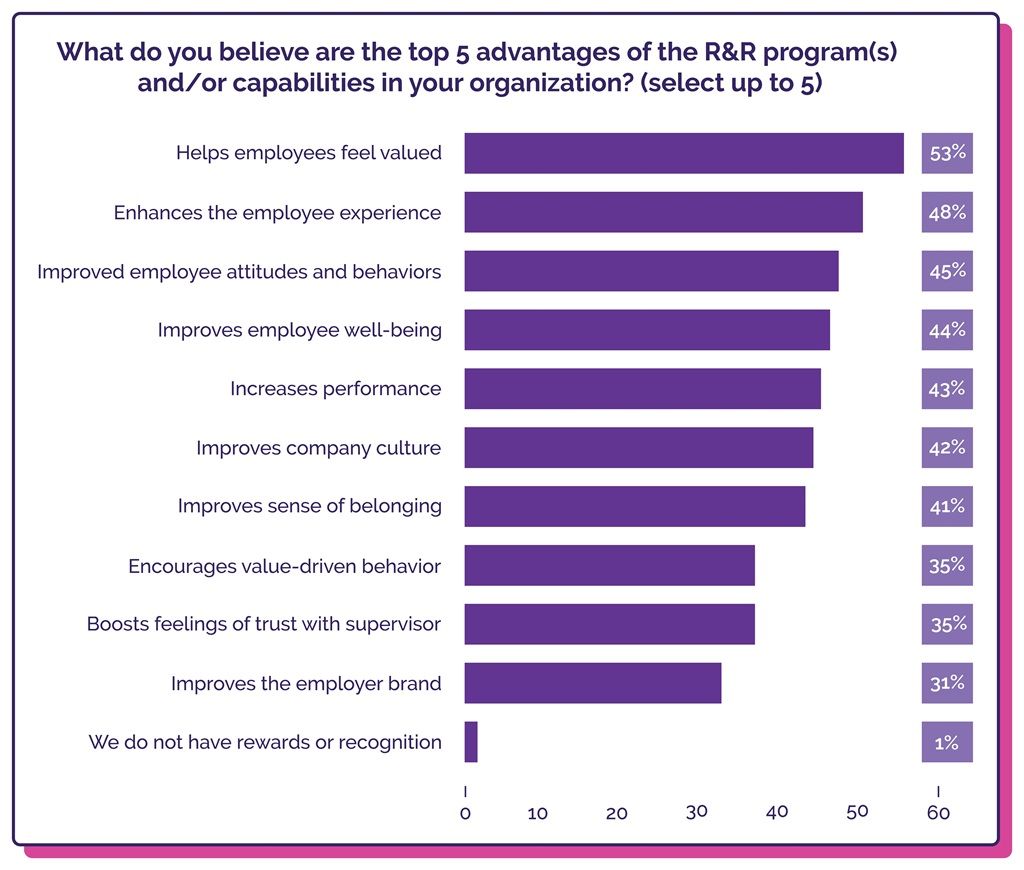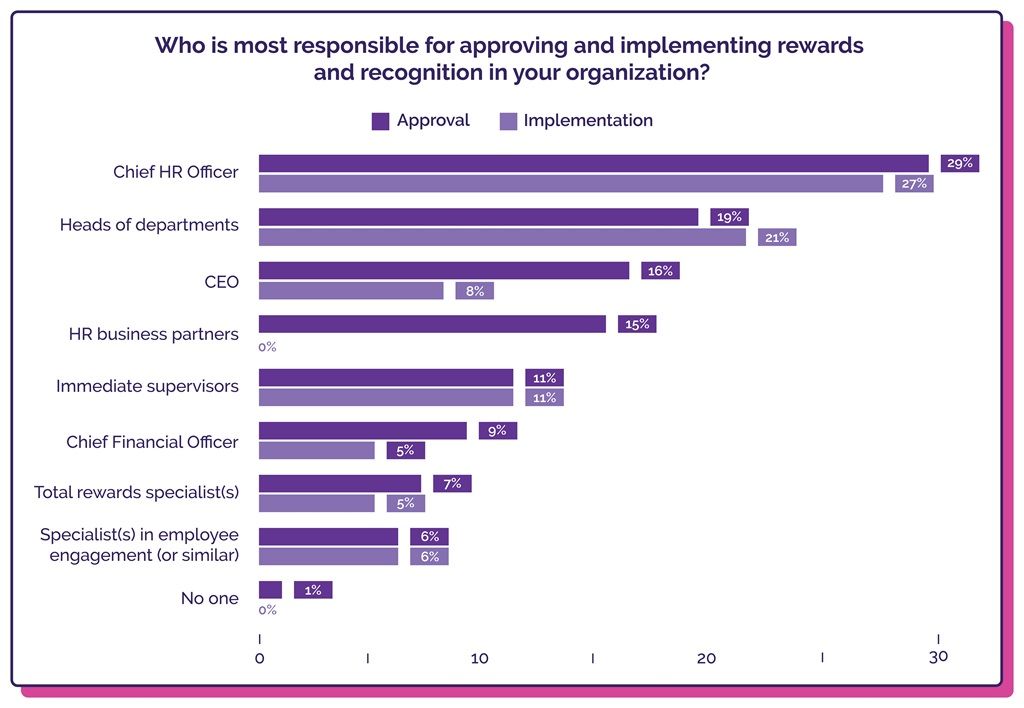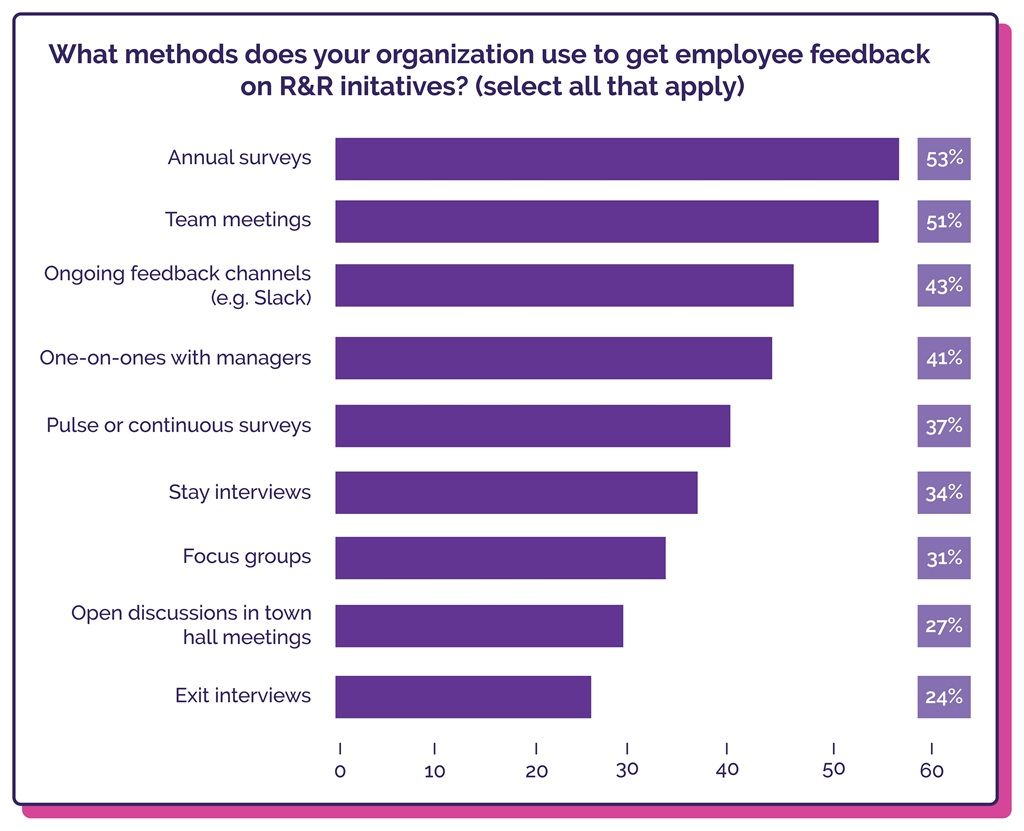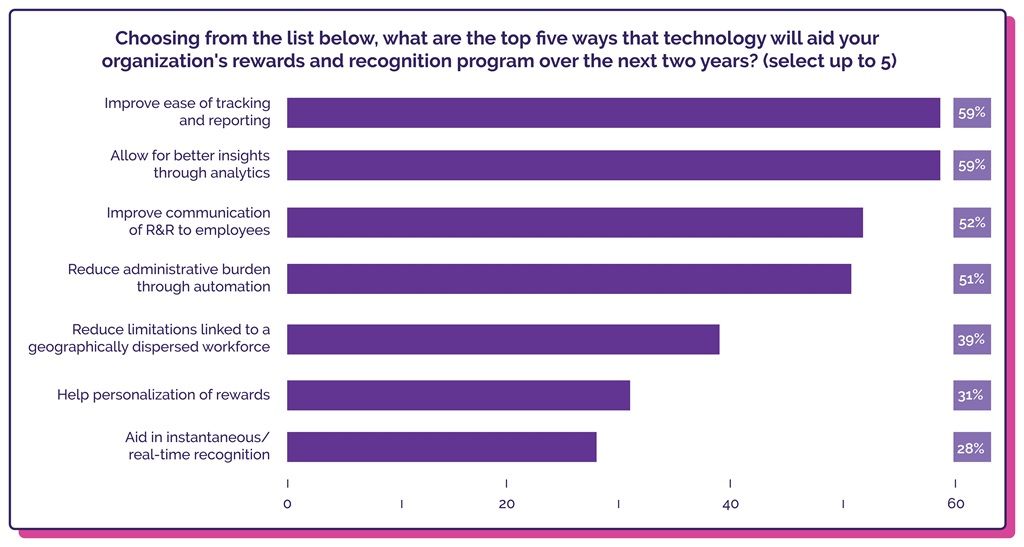Published: Jul 8, 2025Time to read: 8mins Category: Compensation
5 Major Talking Points From HR.com’s 2025 State of Rewards and Recognition Report
Table of contents
Rewards and recognition (defined by the HR Research Institute as “tangible perks” and “public or private employee appreciation”) were recently the subject of an HR.com report examining key employee compensation trends. PeopleFluent Product Marketing Manager Katie Coleman has picked out five of the biggest talking points from the report. Read on to discover how organizations are using proven and innovative ways to foster a culture where employees feel valued.
1) Competition Is Fierce—So You Need to Stand Out
72% of the HR professionals surveyed in this year’s report rate the effectiveness of their organization’s recognition programs as “high” or “very high” (38% and 34% respectively). 80% say the same about their rewards programs (38% and 42% respectively).
Although it’s certainly true that the HR professionals delivering the plans are more likely to be motivated to perceive those plans as effective, the survey did establish a definition for “effective” as “your organization getting the desired impact based on its goals.” Assuming that the responses follow this definition—and the anonymity of the report means there isn’t really any reason not to do so—it seems that the vast majority of organizations are already doing rewards and recognition right.
Of course, if almost everyone’s doing something right, it becomes that much more difficult to stand out among a sea of similarly good options—unless, you’re missing the mark and standing out for all the wrong reasons!
Nonetheless, respondents are confident of the advantages of a robust rewards and recognition program. As the chart below shows, over 40% of respondents link their programs to various improvements in belonging, company culture, performance, well-being, attitudes and behaviors, and employee experience.

Figure 1: Responses to the question “What do you believe are the top 5 advantages of the R&R program(s) and/or capabilities in your organization?”
2) The Majority Use Formal Programs and Processes, But Responsibility for Approval and Implementation Is More Variable
The report makes a distinction between formal and informal rewards and recognition programs and processes:
- Formal programs and processes are “generally based on structured systems, programs and policies”
- Informal programs and processes are generally impromptu acts of reward and recognition, such as “job well done” messages
According to the survey, 87% of organizations use some degree of formal program and process, with 47% considering their approach to be almost entirely formal, and 40% using a mixture of informal and formal approaches. This leaves just 8% of organizations using a purely informal approach (the remainder operate service-award-only programs.)
There’s greater variation in how organizations approach approval and implementation, however. In both cases, the responsibility most commonly falls to the Chief HR Officers, who are accountable for program approval at 29% of organizations and implementation at 27% of organizations. However, as the chart below shows, at many organizations, a number of other key individuals may take on these responsibilities:

Figure 2: Responses to the questions “Who is most responsible for approving rewards and recognition in your organization?” and “Who is most responsible for implementing rewards and recognition in your organization?”
EXPLORE SKILLS-BASED COMPENSATION | ‘What to Expect When Implementing a Skills-Based Compensation Strategy’
3) Employee Feedback Underpins Program Effectiveness, But Some Organizations Struggle With Goals and Application
The majority of organizations surveyed will shape their programs by taking feedback into account. 78% say they take employee input into account to a high (53%) or very high degree (25%) when introducing new initiatives. However, the report also notes that the cadence of these check-ins matters, and calls the most common method of feedback collection, annual surveys (53%), “too infrequent to capture real-time insights or evolving employee needs”.
Thankfully, a range of other methods are in use, as can be seen in the chart below:

Figure 3: Responses to the question “What methods does your organization use to get employee feedback on R&R initiatives?”
Furthermore, the report also found that 49% of organizations review the effectiveness of their programs at least quarterly.
Despite the generally widespread confidence that these programs are effective, many organizations still encounter challenges delivering the best possible packages. The following are the five most commonly cited:
- A lack of measurable performance goals, resulting in unclear criteria and a lack of fairness in the distribution of rewards and recognition (36%)
- A lack of managerial training on best practices (32%)
- An inconsistent application of rewards and recognition programs, leading to accusations of impartiality (32%)
- A lack of transparency in the implementation of the programs (31%)
- Poor communication and visibility of programs within the organization (31%)
READ UP ON JOB EVALUATION RECOMMENDATIONS | ‘4 Essential Job Evaluation Methods for Compensation Benchmarking Success’
4) Tracking, Analytics, and AI Are Among the Main Near-Future Improvements Organizations Will Make
Looking at the future of rewards and recognition initiatives, the top three priorities cited by respondents include nurturing a culture that encourages rewards and recognition (46%), a greater emphasis on personalization (44%), and “becoming more just-in-time and on-the-spot” (42%). Compensation software has a clear role to play in delivering these outcomes, and a follow-up question on “the top five ways that technology will aid your organization's rewards and recognition program over the next two years” acknowledges this.

Figure 4: Responses to the question “What are the top five ways that technology will aid your organization’s rewards and recognition program over the next two years?”
As can be seen in the chart above, HR professionals anticipate looking to their software to improve ease of tracking and reporting, as well as gaining better insights through analytics (both featuring in 59% of responses). They also see avenues for improving communication of rewards and recognition (52%), reducing administrative burden (51%), and personalizing rewards (31%) through technology.
Additionally, over half of all respondents acknowledge that AI’s biggest strength is its capacity to improve personalization—54% believe it will impact this specific use case in the next two years. Further uses include tracking performance (47%) and helping identify bias (34%). Only 6% said AI will have no impact on rewards and recognition activity.
EXPLORE SOFTWARE’S ROLE IN PERSONALIZATION | ‘How Compensation Management Software Helps You Customize Total Rewards and Retain Your Top Talent’
5) What Sets More Effective Rewards and Recognition Organizations Apart
A common feature of the HR Research Institute’s reporting is to use the opening organizational effectiveness survey question to split respondents into two groups: “leaders” and “laggards”. Here, that means those organizations with more or less effective rewards and recognition programs, respectively. This allows for a comparison to be made between the two groups, hinting at practices that may be more or less aligned with an effective approach. Leaders are:
- Four times more likely to invest in setting up formal rewards and recognition programs (52% versus 13%)
- More likely to use results-based nomination for rewards and recognition (43% versus 29%), and significantly more likely to use customer nomination (56% versus 18%) and self-nomination (32% versus 4%)
- Six times more likely to review the effectiveness of their programs quarterly or semi-annually (80% versus 16%)
- Six times more likely to examine the impact of rewards and recognition on employee performance metrics (58% versus 9%). 27% of laggards do not evaluate effectiveness at all
- Three times more likely to take employee opinion into account when introducing new initiatives (89% versus 32%)
- More likely to get feedback from stay interviews (37%) than exit interviews (21%)—with laggards exhibiting the opposite tendency (20% using stay interviews and 53% using exit interviews)
DISCOVER MORE INSIGHTS FROM RECENT REPORTS | ‘6 Markers of Total Rewards Maturity From the Future of Compensation and Total Rewards 2024-25 Report’
Get Even More Pay Equity Insights
The five talking points above are just a sample of HR.com’s State of Rewards and Recognition 2025 report. The full, 47-page document drills even deeper into the survey data, with some interesting insights, key takeaways, and strategic recommendations to inform your own best practices. Read the report to find out:
- How large, midsize, and small organizations differ in their approach
- How closely rewards and recognition are tied to tenure, performance, values, and personal or professional milestones
- The specific measurement organizations use for program effectiveness
- Which rewards are most popular with employees
- How much organizations typically spend on their programs
- And more!
Choose a Compensation Planning Solution That Will Help Your Incentive Strategies Stand Out
Discover how PeopleFluent Compensation can help you successfully manage your rewards and recognition program—contact our team today.